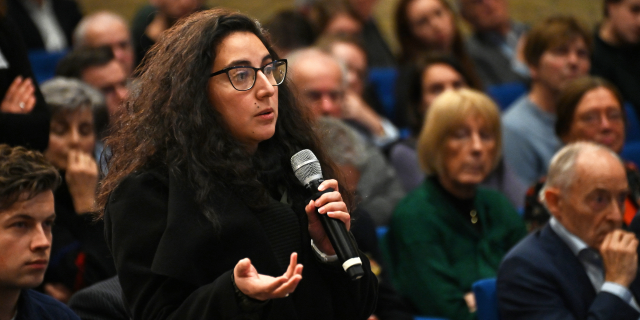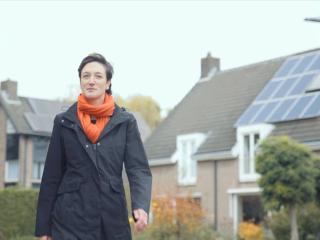Human interaction is the city’s greatest benefit
Cities grow. This has consequences with respect to affordable housing, security, career opportunities, and problems of segregation. How can the government ensure continued quality of life in cities? “It hinges on good rules,” says Harvard Professor Edward Glaeser during the fourth Vrienden van Cobbenhagen Lecture on January 23, 2020.
Vrienden van Cobbenhagen, alumni, students, and university staff meet during the Vrienden van Cobbenhagen Lecture - Urban Society . Professor Edward Glaeser presented the keynote: ‘The Pros and Cons of Urbanization’. They are not disappointed. Glaeser goes through his slides in fast-forward mode, substantiates claims with data, explains causes and effects, and takes those present in the Auditorium on a roaring journey through the history of urbanization.
The benefits of the city
“That we are meeting here face to face today is a sign of what makes cities great,” is Glaeser’s opening sentence. “Because we are in contact with each other, we can work miracles together which we couldn’t achieve alone. Human interaction has advantages like trade, mutual assistance, and information exchange. There are also downsides, for instance, crime and the spreading of viruses. An effective public sector ensures that contacts run smoothly. The city is not the skyline, but the people who live there. The infrastructure and buildings don’t work if they don’t serve citizens’ needs.”
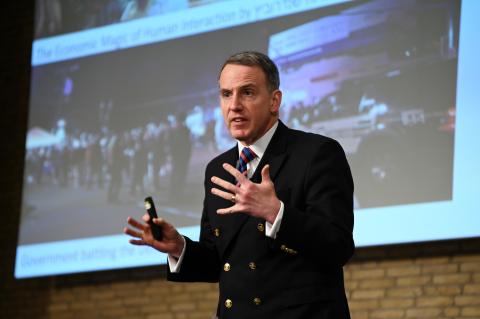
The city is not the skyline, but the people who live there
Rise and fall
How did urbanization arise? Glaeser goes back to the end of the 18th century when the Industrial Revolution caused people to flock to the cities. The 1960s showed a countermovement. With the rise of cars and highways, the city lost its popularity. Companies withdrew from the city in search of cheaper labor.
Death of distance
Large cities are now making a comeback. Why is that? Glaeser: "This is surprising because the development of cars, airplanes, radio, television, and the internet has led to a ‘death of distance’. "Still, personal interaction continues to be of great value. If you want to become smart, you need to surround yourself with smart people. If you are not face to face, you cannot read each other’s body language or see how your message has impacted the other person.
Learning from each other
“In the modern economy, knowledge is more important than space.” It appears that cities with the highest human capital – so the places where the ‘smartest’ people live – have the greatest level of development. Learning is crucial, except that this learning does not so much take place at university but rather in the streets and in the office. Colleagues learn from each other: ‘Knowledge is in the air.’
Entertainment and design
Although the city was first designed as a place to live and work in, since the 1930s, it has also become the place to go to consume and be entertained. “Tourism greatly increased. Thirty years ago, New Yorkers did not want to live downtown, but now it is a consumer city. The popularity of suburbia has plummeted. The city used to be a dangerous place. Fifty years ago, it would have been unthinkable to share a car with someone you didn’t know. Who knows there might be a dead body in the trunk! New companies like Airbnb and Zipcar make use of technology. That technology has created trust.”
Better pay and more happiness
Why do people move to the city? The denser an area is populated, the higher the average wage. The reason is the higher level of education and faster salary growth. "It is important to remember that there is no pathway out of poverty into prosperity that does not run through city streets." The infant mortality rate is lower in cities, wages are higher and people are happier there. These figures are not the same for every city, of course, but in India even a child earns more begging in the street of a large city than it does with daily work in the countryside. These differences are greatest in developing countries.
Five challenges the city is faced with
What challenges does the city face? Glaeser mentions five examples. A common factor is that the public sector has not kept up with private sector success in cities.
1. Unequal opportunities
First, there is the lack of upward mobility of children of poor parents in big American cities. "They're more likely to end up in prison than they are to climb out of poverty." There is more segregation. Although both rich and poor people live in the city, little changes in the composition of these groups. There are ‘isolated pockets of poverty’ where children grow up without interacting with rich and well-educated people.
2. Affordable housing
The second challenge is affordable housing. The government has to make sure that supply meets demand in order to keep home prices affordable. House prices in popular cities will soar unless the government enables enough building. The higher you build, the more nature and open space is preserved and the less CO2 is emitted because people live on fewer square meters and need less energy for heating and cooling. In that sense, cities are not a threat to sustainability. There is also a social justice element. "If you say no to construction, you say no to a family who wants to experience the city as an engine of opportunity.”
3. Brain drain
The third point: what about the rural areas that are left behind? Lack of jobs leads to idleness and unhappiness, especially for unemployed prime-age males. Joblessness remains fixed, among other things, because mobility rates have declined precipitously and skilled people moving out has led to a brain drain. Education is crucial.
4. Health
The fourth challenge is health in a city. This has always been a challenge: "A boy born in New York in 1900 could be expected to live seven years less than the national average." Today, life expectancy is three years longer in New York than outside. This was achieved by regulation and lots of investment. The infrastructure for clean water in New York is a case in point. It was not until the health board required landlords to connect the poorer parts of the city to the clean water network, and imposed fines if they didn’t, that the mortality rate and the risk of a cholera epidemic dropped dramatically.
5. Rule of law
A city needs rules to keep it livable. "If you build highways, people will drive on them." If you want to reduce traffic, you need to make rules that affect users directly. ‘There is no better alternative than road pricing.’ Another challenge is safety, especially the vulnerable position of women. When the rule of law fails, women suffer particularly. In Zambia, women stick to a small number of low-paying industries where they can work with other women because they can’t trust the men. Female entrepreneurs are cut off from the urban ability to learn from other people. What makes a city resilient? “Making room for many, small-scale entrepreneurs. For cities with a few monolithic companies, it is difficult to be flexible, whereas small business can more easily reinvent themselves and identify opportunities in other markets.”
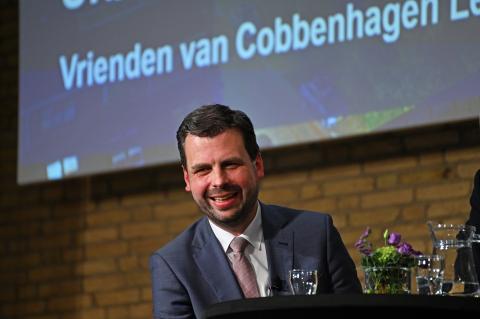
Tilburg is now a strong university city that drives innovation
Zooming in on Tilburg
While Glaeser shed an international light on urbanization, alderman Berend de Vries zooms in on Tilburg. The city in which Tilburg University is located boasts a flourishing past in the textile industry. In the late 19th century, approximately 13,000 residents worked in this sector. After 1950, companies left for low-wage countries and Tilburg had to reinvent itself, focusing on logistics and business. De Vries: “Like Eindhoven, Tilburg is now a strong university city that drives innovation. 13 to 15 % of our residents are students. We are now in transition from low-wage labor in the textile industry to a knowledge city.”
Good ecosystem
“In fact, the Netherlands is one big city,” De Vries continues. “The distance between cities is so small that it does not form a barrier.” The province of Noord-Brabant is a network of cities, universities, and entrepreneurs. What does this mean for Tilburg? “That we must continue to invest in good connections between cities and in close collaboration. I believe in the triple helix: partnerships in which the government, knowledge institutes, and the business sector work together. It is necessary to give businesses space and opportunities and to create a good ecosystem. We focus on the themes of data science, artificial intelligence, and digitalization.”
Tilburg's strategy
What is the role of the city? “The city’s strategy is to create an appealing working and living environment for the people we want to attract to our city. They must be able to feel at home here. A case in point is Piushaven: in the 1990s, it was a neglected backwater but now it has been transformed into a bustling area. Or Spoorzone: from a maintenance depot of the Dutch Railways to a thriving place for culture, education, and enterprise, with the prize-winning LocHal library at its center. A good example of the power of adaptive reuse and urban regeneration.”
Question time
After Professor Glaeser and alderman De Vries’ lectures, moderator Simone van Trier and people in the audience ask interesting and stimulating questions. For example, whether the city can actually say: ‘These are the people we want to attract’? Glaeser: "It is the job of city government to attract trained and smart people and then to get out of their way. It is not always clear what people you should want to attract. Education could be a good indicator and a diversity of skills would be valuable." Good quality of life is important to attract people, not just nice buildings or employment opportunities. The government has a responsibility in matters like security, culture, and leisure activities.
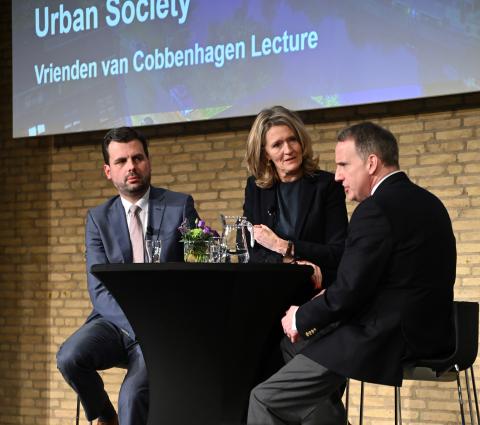
Can a city say 'These are the people we want to attract' ?
Role of the government
Professor Glaeser emphasizes the importance of good regulation and rule-keeping by the government. What is the alderman’s take on this? "In the Netherlands, a lot is decided on national or provincial levels. As a city, you have little leverage on these policies. The province, for instance, makes construction decisions based on demographics. The problem is that higher levels of government are slow to react to current issues. Decision-making takes years. What we do have an influence over is bringing the university closer to the city, via a kind of knowledge axis. At the moment, the campus is located on the edge of the city. Together with the university and the two universities of applied sciences in Tilburg, we are going to bring knowledge into the city by means of Mindlabs."
Personal interaction
After the moderator’s concluding speech, those present, their heads full of new ideas, relocate to the reception area for drinks and personal interaction. Among the hubbub and the swinging live music, former fraternity members re-engage and staff, students, and alumni have animated conversations. They exchange knowledge and business cards. Knowledge is in the air.
Watch the entire Lecture
More about the Vrienden van Cobbenhagen Lecture
Prior to the keynotes by professor Glaeser and Berend de Vries, three sessions took place on Urban Society. Find out more about the keynote speakers, these Urban Sessions and the 'Lectures' organized before by alumni network the Vienden van Cobbenhagen, together with Tilburg University Society and the Development & Alumni Relations Office.
Photography: Freddie de Roeck, Frans van Aarle
Date of publication: 11 February 2020
